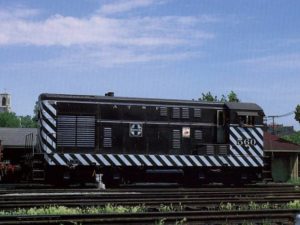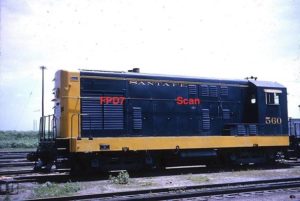Diesel Service Report, Sept 12th, 2020
SF560 Project
One of the most important decisions that we must make on the project is the selection of the paint scheme that will be used for the restoration. Last week it was revealed that we would be taking into account the suggestions from those of you that donate to the project.
From a museum perspective, we need to know what each of the different paint schemes entails. It is important that when a paint scheme is selected, that the locomotive is then configured to accurately represent the time period coinciding with that paint scheme.
So far, we only know of two paint schemes being considered. One is the black and white Zebra scheme and the other is the blue and yellow scheme. Unfortunately, last week I incorrectly referred to the blue and yellow scheme as being sometimes called a Kodachrome scheme. Thanks to Evan Werkema, I now know that the Railfan use of “Kodachrome” refers to the red and yellow scheme developed for the failed Santa Fe – Southern Pacific Merger, which did not come about.
Evan said that the blue and yellow scheme is sometimes referred to as the “Pinstripe” scheme or the “Bookend” scheme. Those are the nicknames that would apply to all of locomotives painted in those color schemes. Another nickname that has now cropped up for the short H12-44 Fairbanks Morse, like our SF560, is “shoebox”. We only heard about that this past week and don’t know how common it was.
As the research continues, we realize that Santa Fe made very few changes to the H12-44 Fairbanks Morse locomotives. The only change that we know of now, is the addition of integral class lights on the front of the locomotives. These were added in the early to mid 1970’s. The locomotives were first painted and operated with the blue and yellow color scheme for a few years before the “built-in” class lights were added.
So, if the Zebra scheme is selected, we will need to remove the built-in class lights and reactivate the portable class light mounting features which are already in place. We have a spare set of refurbished portable class lights to use if the Zebra scheme is selected.

The Zebra scheme was on the locomotive when it was delivered to Santa Fe from Fairbanks Morse.
This (left) is a 1963 photo of SF560 which was taken by Fred Scott and published in the book “Santa Fe, 1940-1971 In Color Volume 1”. (Thanks Evan. Nice find.) Since this was taken about 5 years after delivery, note the slight rust on the roof and the less than pristine sea foam green paint on the inside of the cab door. We also do not know what the multi-color swatch is just to the left of the battery compartment. It appears to be temporary sign of some kind. What we do know, is that on-line photographs of the Zebra scheme are exceedingly rare. I haven’t researched every remaining Fairbanks locomotive but tend to think that there are very few left with the Zebra stripe scheme.
 The later color scheme is the Blue and Yellow configuration (right). This scheme was began in the mid 1960’s and retained through the rest of life of the Fairbanks locomotives owned by Santa Fe. It was the color scheme still on the locomotives when they were sold by Santa Fe in the late 1970’s. However, this scheme had two versions. Originally, they did not have built-in class lights. Sometime during the last few years of operation, Santa Fe modified the locomotives and added those lights. That later version is how our SF560 is configured.This next picture was found on Facebook in the “Santa Fe Fans Worldwide” page. It was taken in Kansas City in 1965 by an unknown photographer. It was posted to the Facebook page by Keith Bunner. I don’t know what the red FPD7 or the Scan signs refer to. There was no copyright information on the Facebook photo other than it was posted by Mr. Bunner.
The later color scheme is the Blue and Yellow configuration (right). This scheme was began in the mid 1960’s and retained through the rest of life of the Fairbanks locomotives owned by Santa Fe. It was the color scheme still on the locomotives when they were sold by Santa Fe in the late 1970’s. However, this scheme had two versions. Originally, they did not have built-in class lights. Sometime during the last few years of operation, Santa Fe modified the locomotives and added those lights. That later version is how our SF560 is configured.This next picture was found on Facebook in the “Santa Fe Fans Worldwide” page. It was taken in Kansas City in 1965 by an unknown photographer. It was posted to the Facebook page by Keith Bunner. I don’t know what the red FPD7 or the Scan signs refer to. There was no copyright information on the Facebook photo other than it was posted by Mr. Bunner.
You will notice that it does not have the built-in class lights.
Both Zebra Stripe and the Blue and Yellow paint schemes are under consideration.
In addition to the class light issues, note that the Builders Plate is shown in this photo. Of course, those are missing from SF560. However, there is a company that offers exact duplicates and we have the technical data for them to engrave on the plates.
Another issue that pertains to both paint schemes is the missing front and rear steps. Those were removed long ago in keeping with FRA safety regulations. We will add them back onto SF560 regardless of which paint scheme is selected.
One other decision has been made regarding the restoration. We will now plan to remove both trucks for cleaning, inspection, and painting. During the past few years, we have removed several trucks from under other locomotives for various reasons. Each time we remove them, we find problems that we didn’t know where there. Because of the history of this locomotive, and how dirty it is underneath, it is in our best long term interest to remove each of the trucks. Hopefully, we won’t find anything seriously wrong. If we do need parts, we have the Trona Baldwin locomotive trucks for parts donors.
This past week, John Salvini repaired the auxiliary generator regulator. The batteries now charge and remain steady at the selected voltage. However, he also found a few water leaks that need to be attended to at some point. Near term, patches will be clamped over the leaks and the total replacement of the leaking pipes will be addressed later in the program.
During John’s work this past week, he noted that black smoke again appeared in the exhaust stack prior to the engine starting. The most probable cause is oil that accumulates on top of the bottom pistons after the engine is shut down. If the rings on the upper pistons are not sealing correctly, oil from the upper crankshaft area can leak past the upper piston rings and drop down onto the lower pistons and stay there until the engine is started. John also noted that loose oil is starting to splatter out of the exhaust stack again. This week he will inspect the exhaust manifold to see if loose oil is accumulating in there again and attempt to see if it is coming from the cylinders or the blowers.
Funding for the project is needed. To those that have donated already, thank you very much. The project cannot proceed without the financial support. The preliminary estimate is $40,000. Shortly, we will be publishing a direct link to SCRM’s web site for making donations.
Dave Althaus

